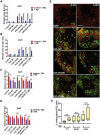Traumatic injury induces stress granule formation and enhances motor dysfunctions in ALS/FTD models
- PMID: 29432563
- PMCID: PMC6455923
- DOI: 10.1093/hmg/ddy047
Traumatic injury induces stress granule formation and enhances motor dysfunctions in ALS/FTD models
Abstract
Traumatic brain injury (TBI) has been predicted to be a predisposing factor for amyotrophic lateral sclerosis (ALS) and other neurological disorders. Despite the importance of TBI in ALS progression, the underlying cellular and molecular mechanisms are still an enigma. Here, we examined the contribution of TBI as an extrinsic factor and investigated whether TBI influences the susceptibility of developing neurodegenerative symptoms. To evaluate the effects of TBI in vivo, we applied mild to severe trauma to Drosophila and found that TBI leads to the induction of stress granules (SGs) in the brain. The degree of SGs induction directly correlates with the level of trauma. Furthermore, we observed that the level of mortality is directly proportional to the number of traumatic hits. Interestingly, trauma-induced SGs are ubiquitin, p62 and TDP-43 positive, and persistently remain over time suggesting that SGs might be aggregates and exert toxicity in our fly models. Intriguingly, TBI on animals expressing ALS-linked genes increased mortality and locomotion dysfunction suggesting that mild trauma might aggravate neurodegenerative symptoms associated with ALS. Furthermore, we found elevated levels of high molecular weight ubiquitinated proteins and p62 in animals expressing ALS-causing genes with TBI, suggesting that TBI may lead to the defects in protein degradation pathways. Finally, we observed that genetic and pharmacological induction of autophagy enhanced the clearance of SGs and promoted survival of flies in vivo. Together, our study demonstrates that trauma can induce SG formation in vivo and might enhance neurodegenerative phenotypes in the fly models of ALS.
Figures






References
-
- Kuusisto E., Salminen A., Alafuzoff I. (2001) Ubiquitin-binding protein p62 is present in neuronal and glial inclusions in human tauopathies and synucleinopathies. Neuroreport, 12, 2085–2090. - PubMed
-
- Terni B., Rey M.J., Boluda S., Torrejon-Escribano B., Sabate M.P., Calopa M., van Leeuwen F.W., Ferrer I. (2007) Mutant ubiquitin and p62 immunoreactivity in cases of combined multiple system atrophy and Alzheimer's disease. Acta Neuropathol., 113, 403–416. - PubMed
-
- Salminen A., Kaarniranta K., Haapasalo A., Hiltunen M., Soininen H., Alafuzoff I. (2012) Emerging role of p62/sequestosome-1 in the pathogenesis of Alzheimer's disease. Prog. Neurobiol., 96, 87–95. - PubMed
-
- Kuusisto E., Salminen A., Alafuzoff I. (2002) Early accumulation of p62 in neurofibrillary tangles in Alzheimer's disease: possible role in tangle formation. Neuropathol. Appl. Neurobiol., 28, 228–237. - PubMed
-
- Arai T., Hasegawa M., Akiyama H., Ikeda K., Nonaka T., Mori H., Mann D., Tsuchiya K., Yoshida M., Hashizume Y. (2006) TDP-43 is a component of ubiquitin-positive tau-negative inclusions in frontotemporal lobar degeneration and amyotrophic lateral sclerosis. Biochem. Biophys. Res. Commun., 351, 602–611. - PubMed
Publication types
MeSH terms
Substances
Supplementary concepts
Grants and funding
LinkOut - more resources
Full Text Sources
Other Literature Sources
Medical
Molecular Biology Databases
Miscellaneous

